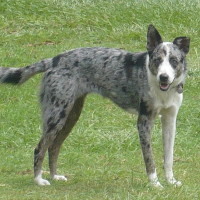Appearance of the Australian Koolie
|
| The Koolie breed was developed for its exceptional guarding instinct and driving ability during training, rather than for its physical appearance. There is therefore more variation in this breed than in many others. They're all athletic, agile dogs, slightly longer than they are tall, but New South Wales Koolie dogs were used to chase cattle out of gullies and dense shrubbery. They are therefore shorter and sturdier than Northern Koolie dogs, which were more often used to drive cattle over long distances. They have a well-proportioned head that bears almond-shaped eyes and a balanced, slightly tapering muzzle, but the eyes can be any color from blue to brown, and sometimes just one, although the medium-length triangular ears are generally held erect, with some individuals having ears that fold forward or to the sides. Although historically there have been a large number of Koolies with merle coloration, color dilution and blue eyes, breeders are increasingly wary of breeding dogs with these characteristics, as they are associated with higher rates of blindness and deafness. |
Temperament of the Australian Koolie
|
| This breed is extremely dedicated and hard-working in the field, and just as dedicated to having fun when they get home. They are loyal and devoted to their families and, although interactions between dogs and children must always be supervised, they tend to be patient with children as well as adults. Although they are alert and bark to warn you that someone is approaching, they don't generally excel as guard dogs due to their outgoing nature. They are generally friendly with humans and other animals, although their enthusiastic behavior and unwavering guard instinct may rub some individuals the wrong way. Like most herding dogs, they are high-energy, high-intelligence animals that require a lot of exercise and attention, and generally do best with a job. They are not only well suited to herding activities, but also to therapy positions, as they tend to have an outgoing, playful attitude, and their willingness and ability to learn and memorize a large number of commands make them good candidates for performance work. |
Needs and activities of the Australian Koolie
|
| It cannot be stressed enough that this is a high-energy breed with intelligence and curiosity. If this breed doesn't get enough exercise and mental stimulation, it will seek it out itself, which can lead to behaviors ranging from irritating to destructive. Daily exercise should include at least one to two hours of vigorous activity every day. If you don't own your own livestock, daily walks and runs can be supplemented with alternative activities such as advanced obedience training, agility training and even acrobatic canine dancing. |
Maintenance of the Australian Koolie
|
| Although the Koolie can be coated in a single short coat or a slightly longer double coat, the grooming requirements for the breed are quite similar. They only need to be bathed occasionally, and more frequent bathing can strip them of the natural oils that make them more resistant to water and weather. Both varieties shed moderately and should be brushed one to three times a week with a smooth brush, stiff bristle brush or rubber curry comb. The double-coated variety may be subject to heavier shedding at the change of season, and may require additional brushing sessions during this period. Koolie teeth should be brushed three times a week and nails trimmed monthly. |







 English (United Kingdom)
English (United Kingdom)